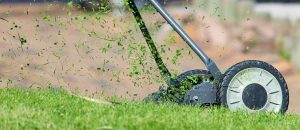 Doug Soldat, Extension Turfgrass and Urban Soil Specialist
Doug Soldat, Extension Turfgrass and Urban Soil Specialist
Department of Soil Science
UW-Madison College of Agricultural and Life Sciences
djsoldat@wisc.edu
(608) 263-3631
Total Time – 3:51
0:13 – Keeping your lawn healthy after spring showers
0:52 – Damaged sections of your lawn
1:33 – Weed control
2:24 – Grass clippings – what to do with them
2:47 – Appropriate mowing frequencies
3:20 – Predictions for the season
3:39 – Lead out
Transcript:
Adam Wigger: “Healthy Lawns, Happy People”. We’re talking today with Doug Soldat, Extension Turfgrass and Urban Soil Specialist, professor in the Soil Science Department, University of Wisconsin-Madison, Division of Extension, in the college of Agricultural and Life Sciences, and I’m Adam Wigger. Doug, how should Wisconsinites keep their lawns healthy after all these spring showers?
Doug Soldat: Yeah it’s been a wet year for sure so that’s delayed people getting out there and working on their lawns. Good news is that I think lawns are healthy, they’re just waiting for some warm weather to start growing again. The best time to fertilize is right about now, around Memorial Day. Feed your lawn, thicken it up, repair any damage that occurred over the winter. So the most important thing that people can do is mow with a sharp mower blade. So think about whens the last time you sharpened your mower blade, ifs it’s been a while, you can’t remember, go get it sharpened. It’s going to make a huge difference in the quality of your lawn.
Adam Wigger: What kind of things can people do to save damaged sections? Should they be calling you, should they be calling some other specialist, or is there any way that they can fix damaged sections on their own?
Doug Soldat: Yeah absolutely. There’s a good publication on the University of Wisconsin Extension learning store called Lawn Renovation that will give you some excellent tips on how to do it. The problem with seeding this time of year is there’s a lot of competition for weeds and other things to come in. So if you have large bare areas, you have no other choice. But if they’re smaller, I would say tolerate the small gaps, allow some of the grass to fill in a bit, and reseed in the fall. The fall is the best time to reseed a lawn.
Adam Wigger: You just mentioned weeds – what should we be doing about weeds? Should we be leaving dandelions for pollinators? Should we be doing other things to get rid of them? What’s your recommendation?
Doug Soldat: yeah weed control is a personal choice. Some people prefer a weed-free lawn and other people like to recognize some of the benefits of some of the weeds that can coexist with a lawn, like dandelions and clover. Clover is my favorite of the bunch. It provides nitrogen from the atmosphere and feeds the grass as well. So if you’re one of the people that likes to control the weeds, the best time to do that is in the fall. So our studies over the years have shown that herbicide applications are much less effective than they are in the fall and the best time to control weeds is right about early October through Halloween when the plants are translocating things, including herbicides, down to their roots.
Adam Wigger: So when people are cutting their lawns this season, what should people be doing with grass clippings?
Doug Soldat: Grass clippings are free fertilizer, so don’t bag those clippings and put them on the street. Make sure that you mulch those clippings back down to the lawn. They’ll be broken down by microorganisms and return about the equivalent of a nitrogen fertilizer application for the season.
Adam Wigger: When cutting, how often should we be cutting? How short should we be cutting? How long should we keep it? What’s the good balance?
Doug Soldat: Mow your lawn as high as possible – as high as you can tolerate. Three inches, three and a half inches, that allows the roots to grow deeper, allows the lawn to be more dense. And actually, it makes the grass grow slower. We found that by mowing your grass lower, it sends signals to the plant to grow faster. So you get caught in a loop where you’re mowing shorter and you’re mowing more often. So raise that mowing height up, and again use a sharp mowing blade and you’re gonna have a healthy lawn.
Adam Wigger: Any predictions on how you think the season is going to treat people’s lawns?
Doug Soldat: Every year is a surprise. We’ve had a couple of pretty wet years so I think people are hoping for a more return to normal precipitation but we don’t want to run into the drought like we had in 2012.
Adam Wigger: We’ve been talking today with with Doug Soldat, Extension Turfgrass and Urban Soil Specialist, professor in the Soil Science Department, University of Wisconsin-Madison, Division of Extension, in the college of Agricultural and Life Sciences, and I’m Adam Wigger.



